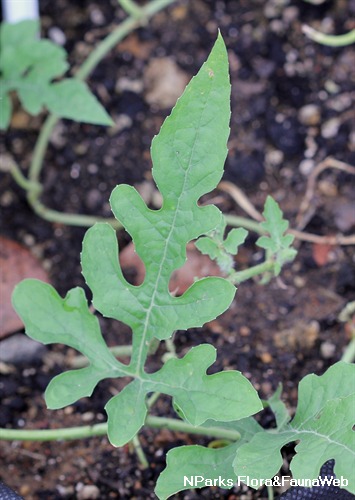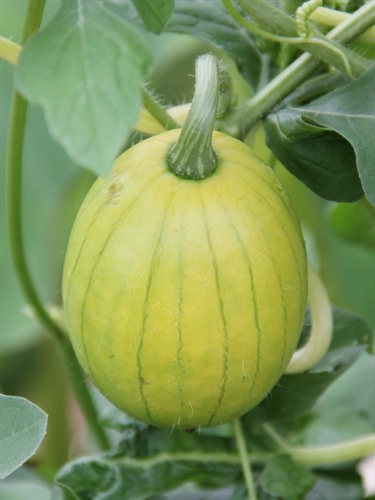
Back
Citrullus lanatus (Thunb.) Matsum. & Nakai
| Family Name: | Cucurbitaceae |
| Common Name: | Watermelon, Tembikai, Semangka, 西瓜 |
Name
Classifications and Characteristics
| Plant Division | Angiosperms (Flowering Seed Plants) (Dicotyledon) |
|---|---|
| Plant Growth Form | Climber |
| Lifespan (in Singapore) | Annual |
| Mode of Nutrition | Autotrophic |
Biogeography
| Native Distribution | South Africa |
|---|---|
| Native Habitat | Terrestrial |
| Local Conservation Status | Non-native (Horticultural / Cultivated Only) |
Description and Ethnobotany
| Growth Form | An annual, monoecious vine. It has a twining growth habit and can grow up from 1.5 to 5m in length. |
|---|---|
| Roots | The root system is extensive and shallow. |
| Foliage | The deeply lobed leaves are alternately arranged along the stem and are oblong-ovate in shape with a cordate leaf base. |
| Stems | The herbaceous stem is angular, grooved and is covered with long, white hairs. |
| Flowers | The pale yellow flowers are solitary and are borne in the leaf axils. The male flowers have 3 stamens while the female flowers have an inferior ovary and a 3-lobed stigma. Both flowers have a 5-lobed calyx and a 5-parted corolla. |
| Fruit | The fruit is a pepo, its shape varies from globular to oblong to elliptical. The colour of the fruit also varies from stripes to mottled or uniform and is hairy or glabrous to the touch. The flesh of the fruit varies from red to yellow. |
| Cultivation | It is best grown in a warm, sunny and dry climate for rapid growth and fruiting. Excessive humidity and rainfall induces excessive vegetative growth and fruit rot. It is best grown in slightly acidic, fertile and well-drained soil with a high amount of organic matter mixed in. Seeds may take 5 to 12 days to germinate. Depending on the varieties, the plant may take 85 to 105 days to mature. Grow the plant in a sunny location with a support or trellis and install a hammock-like structure to hold the fruit as it develops. |
| Ethnobotanical Uses | Edible Plant Parts : Edible Fruits, Edible Seeds Food (Fruit or Vegetable) |
Landscaping Features
| Desirable Plant Features | Ornamental Form |
|---|---|
| Landscape Uses | Parks & Gardens, Small Gardens |
| Thematic Landscaping | Economic Garden |
Plant Care and Propagation
| Light Preference | Full Sun |
|---|---|
| Water Preference | Moderate Water |
| Plant Growth Rate | Moderate |
| Rootzone Tolerance | Well-Drained Soils, Fertile Loamy Soils, Acidic (low pH) Soils |
| Propagation Method | Seed |
Foliar
| Foliage Retention | Evergreen |
|---|---|
| Mature Foliage Colour(s) | Green |
| Foliar Type | Simple / Unifoliate |
| Foliar Arrangement Along Stem | Alternate |
| Foliar Attachment to Stem | Petiolate |
| Foliar Shape(s) | Non-Palm Foliage |
| Foliar Base | Cordate |
Floral (Angiosperm)
| Flower & Plant Sexuality | Unisexual Flowers |
| Flower Colour(s) | Yellow / Golden |
|---|---|
| Flower Grouping | Solitary |
| Flower Location | Axillary |
Fruit, Seed and Spore
| Mature Fruit Colour(s) | Green, Green - Light Green |
|---|---|
| Mature Fruit Texture(s) | Smooth |
| Fruit Classification | Simple Fruit |
| Fruit Type | |
| Mature Seed Colour(s) | Black |
| Seed Quantity Per Fruit | Numerous (>20) |
Image Repository
Others
| Master ID | 31704 |
|---|---|
| Species ID | 6103 |
| Flora Disclaimer | The information in this website has been compiled from reliable sources, such as reference works on medicinal plants. It is not a substitute for medical advice or treatment and NParks does not purport to provide any medical advice. Readers should always consult his/her physician before using or consuming a plant for medicinal purposes. |









